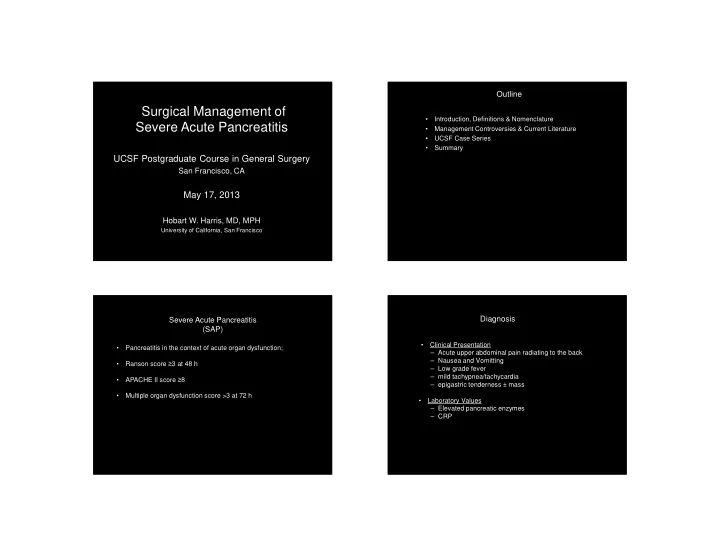

Outline Surgical Management of • Introduction, Definitions & Nomenclature Severe Acute Pancreatitis • Management Controversies & Current Literature • UCSF Case Series • Summary UCSF Postgraduate Course in General Surgery San Francisco, CA May 17, 2013 Hobart W. Harris, MD, MPH University of California, San Francisco Diagnosis Severe Acute Pancreatitis (SAP) • Clinical Presentation • Pancreatitis in the context of acute organ dysfunction; – Acute upper abdominal pain radiating to the back – Nausea and Vomitting • Ranson score ≥ 3 at 48 h – Low grade fever – mild tachypnea/tachycardia • APACHE II score ≥ 8 – epigastric tenderness ± mass • Multiple organ dysfunction score >3 at 72 h • Laboratory Values – Elevated pancreatic enzymes – CRP
Nomenclature Controversies in Management Atlanta Classification (1992) – Arch Surg 1993;128:586-590 1. Acute fluid collections • Indications for Intervention 2. Pancreatic necrosis 3. Pseudocyst • Optimal Timing 4. Pancreatic abscess • Recommended Surgical Approach Acute Pancreatitis Classification Working Group (2008) – www.pancreasclub.com/Atlanta-Classification 1. Acute peripancreatic fluid collections 2. Acute post-necrotic pancreatic/peripancreatic fluid collections 3. Pseudocysts 4. Walled-off pancreatic necrosis Critical issues: age of the fluid collection ( ≥ 4 weeks); necrosis present correlates collection type to treatment recommendation Dutch Prospective Multi-Center Observational Cohort Study Treatment Outcomes in Patients with Necrotizing Pancreatitis (N=639, 2004-2008)
Indications for Surgery • Infected Pancreatic Necrosis with Organ Failure - Level III evidence (Grade B Recommendation) • However: Text - 50% of mortalities were in patients with sterile necrosis - Overall mortality with conservative treatment: 7% (28/397) - 16% had organ failure � 37% mortality - 3% had infected necrosis � 0% mortality • Infection, Instability and Intransigence 10 5 Optimal Timing Optimal Timing • Dutch study favors delaying intervention and when possible for at least 4 weeks - Level III evidence (Grade B recommendations) • However: - lack of randomization confounds interpretation of this conclusion Text - data are not corrected for actual start of illness - 50% who underwent an intervention were transferred from another hospital • When the patient is medically optimized Mortality 56% 26% 15% <.001 Gastroenterology 2011;141:1254-1263
Surgical Approach N Engl J Med 2010;362:1491-1502 Dutch Multi-Center RCT n = 88 with Infected Pancreatic Necrosis Randomized to Open Necrosectomy or “Step-up” approach Step-up approach was associated with fewer complications (40% vs 69% p=0.006); - 35% of patients in Step-up group were treated with drainage only - 7% of patients in Step-up group required Open Necrosectomy - Mortality did not differ between the two groups (19 vs 16% p=0.70) Surgical Approach Recommended Surgical Approach Blunt Necrosectomy & Reptroperitoneal “ Marsupialization ” • Minimally Invasive Approach - Step-up approach supperior to Open Necrosectomy (40% vs 69%, p-0.006) • Technically straightforward - 35% of patients in Step-up group were treated with drainage only - 7% of patients in Step-up group required Open Necrosectomy • Well-tolerated by critically-ill patients - Mortaity did not differ between the two groups (19 vs 16%, p=0.70) - Level Ib evidence! These data need to be confirmed • Avoids sacrifice of viable pancreas • However: • Enables spontaneous drainage & access for debridement of evolving - Requires strong IR support (frequency of manipulations & access) retroperitoneal necrosis while limiting intra-peritoneal trauma - Decreased composite complication score with MIS - No difference in mortality compared to open necrosectomy • Acceptable complication rates • Blunt Necrosectomy with Retroperitoneal Marsupialization • Reduction in mortality
Case Presentation past 2 days following a “ big night ” on the town. Intermittent N/V, anorexia. 38M c/o acute onset severe RUQ & epigastric pain radiating to his back, for the PMHx Unremarkable. No Meds or PSH PE: T = 39.2 o C, anicteric, distended abdomen, tender epigastrium. Labs: WBC = 19K, Hct 57%, Amylase 343, ALT 417, Glucose 260, BMP & LDH WNL, Base Deficit -14. KUB: Adynamic Ileus, No free air or calcifications. Initial conservative management HD # 7 underwent exploratory laparotomy due to spiking fevers, abdominal distention and tenderness clinical instability and concern for infected necrosis.
Demographics UCSF Experience Age 48 years • Retrospective review evaluating outcomes of the surgical (range 20-79 years) management of necrotizing pancreatitis Gender 63% male Ethnicity • 1994-2012 Hispanic 38% White 41% • 59 patients with CT-documented necrosis African-American 9% Asian 12% • Combined county and tertiary hospital experiences of a single surgeon Idiopathic (19%) Other Gallstones (9%) (30%) Alcohol (44%) Severity Assessment Indications for Surgery • Ranson Score (0-11; 19/59): 5.2 + 2.0 • Evidence of infection or sepsis: 44% - Pre-operative CT-guided FNA • Balthazar CT Score (1-10; 59/59): 7.3 + 2.8 - 42% (25/59) had a score of 10 • Clinical instability: 18% - persistent/recurrent hypotension - worsening respiratory function - worsening acidosis >50% Necrosis (62%) • Clinical intransigence: 44% 0% Necrosis (2%) - failed repeated attempts to wean off vasopressors and/or mechanical ventilation <30% Necrosis (26%) - Inability to tolerate an oral diet 30-50% Necrosis (10%)
Outcomes Summary Outcomes Summary Necrosectomies (#) 3 (range 1-15) Morbidity ARDS (29%) Time from Diagnosis to OR 60 days (range 5-150) Sepsis (27%) Time from Admission to OR 15 days Fistulas (24%) (range 0-65) AKI (17%) Infected Necrosis 57% Incisional hernia (5%) Abscess (3%) Antibiotics (# used) 4 Endocrine/Exocrine Dysfunction Insulin (37%) (range 0-17) Enzymes (12%) TPN administration 27 days (range 0-111) Mortality 7% ICU LOS 31 ± 41 days Hospital LOS 61 ± 52 days Summary • Severe acute pancreatitis remains a complex, lethal condition; • Objective severity assessment is critical to optimal management; • The patient’s clinical condition should dictate surgical intervention; • Minimally invasive surgical techniques have extended the interventional armamentarium; • Blunt necrosectomy remains a safe and effective surgical approach.
Recommend
More recommend